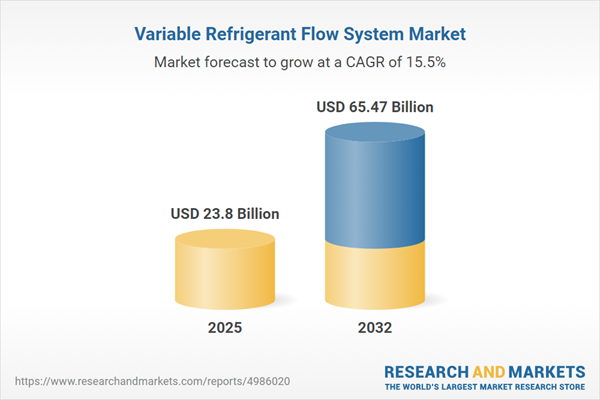Speak directly to the analyst to clarify any post sales queries you may have.
Variable Refrigerant Flow (VRF) systems are redefining how senior facility decision-makers approach climate control, combining operational efficiency with advanced sustainability features. Flexible deployment, strong asset management potential, and a precise response to evolving regulatory needs position VRF systems as a cornerstone of modern facility strategies across multiple property types.
Market Snapshot: Strategic Outlook for the Variable Refrigerant Flow System Market
The global Variable Refrigerant Flow system market is demonstrating significant momentum, with revenues forecasted to grow from USD 20.62 billion in 2024 to USD 23.80 billion in 2025 and projected to reach USD 65.47 billion by 2032. This path reflects a compound annual growth rate (CAGR) of 15.53%. The trend is supported by increased demand for smart HVAC solutions and the ever-expanding requirement for operational resilience within property portfolios. Market expansion is also driven by the imperative to comply with regulatory updates and to introduce adaptable, energy-efficient solutions that support enterprise asset management and sustainability targets.
Scope & Segmentation: Key Drivers for VRF Adoption
- System Types: Heat pump and heat recovery VRF solutions offer custom strategies for climate control. Commercial offices, healthcare, and hospitality facilities experience significant value from flexible temperature management that adapts to changing occupancy or operational priorities.
- Components: Modular designs in both indoor and outdoor units allow organizations to scale system capacity in line with expanding property needs or renovations. This design ensures adaptability for property managers with portfolios that may grow or evolve rapidly.
- Capacity Ranges: Solutions are available for properties of various sizes, from compact spaces to large campuses. Larger models address the needs of high-volume or multi-use buildings, while smaller units support targeted upgrades in segmented areas.
- Installation Types: VRF systems fit both new construction and retrofit projects. This versatility makes it easier for organizations to future-proof building systems or integrate digital control platforms as requirements evolve.
- End Uses: VRF applications cover healthcare, education, industrial, retail, hospitality, and residential settings. Their adaptability helps organizations meet compliance standards, improve energy performance, and achieve greater agility as operational needs shift.
- Regions: Implementation patterns vary based on local climate, energy efficiency policies, and procurement strategies, with adoption observed in North America, Latin America, Europe, the Middle East, Africa, and Asia-Pacific. Each region’s market dynamics prompt tailored system configurations and sourcing decisions.
- Key Companies: Industry leaders such as Daikin Industries, Mitsubishi Electric, LG Electronics, Toshiba Carrier, Fujitsu General, Panasonic, Samsung Electronics, Hitachi, Gree Electric Appliances, and Midea Group refine product portfolios to address local requirements and the changing expectations of a global customer base.
Key Takeaways for Senior Decision-Makers
- VRF systems introduce adaptability essential for keeping facility strategies aligned with regulatory and operational shifts across diverse real estate assets.
- Automated monitoring and digital diagnostics support predictive maintenance, enabling proactive management and reducing unplanned operational disruptions.
- Advanced technologies, such as inverter-driven compressors and innovative refrigerant formulations, enable organizations to strengthen sustainability and maintain compliance in multiple facility environments.
- Building relationships with regional or multinational vendors provides robust procurement options and supports system continuity beyond initial installation.
- AI-powered interfaces and digital controls streamline energy management processes, equipping organizations to deliver on digital transformation initiatives across extensive property networks.
Tariff Impact: Cost Management and Supply Chain Strategies
Upcoming U.S. tariffs in 2025 are prompting enterprises to adapt VRF system procurement strategies. The emergence of regional manufacturing centers, combined with modular component sourcing, helps reduce cost pressures and delivers resilience to project timelines. These improvements strengthen supply chains, support agile response to market changes, and reinforce post-installation service standards across property portfolios.
Methodology & Data Sources
This analysis is based on direct interviews with top industry decision-makers and comprehensive secondary research. The approach ensures that insights are closely aligned with the needs of executives responsible for climate control, asset management, and sustainability in large-scale property holdings.
Why This Report Matters
- Presents clear analysis on how regulatory, technological, and sourcing shifts affect long-term facility strategy and capital investment decisions.
- Empowers leaders in facilities and procurement to make evidence-based supplier choices and respond confidently to risks posed by evolving regulatory environments.
- Delivers practical recommendations to help organizations implement digital transformation and enhance operational management across geographically dispersed sites.
Conclusion
Leveraging scalable VRF system technologies and broadening supply partnerships equips organizations to meet evolving facility management demands. This strategy supports continuous improvement in sustainability and strengthens the resilience of property assets in competitive environments.
Additional Product Information:
- Purchase of this report includes 1 year online access with quarterly updates.
- This report can be updated on request. Please contact our Customer Experience team using the Ask a Question widget on our website.
Table of Contents
3. Executive Summary
4. Market Overview
7. Cumulative Impact of Artificial Intelligence 2025
Companies Mentioned
The companies profiled in this Variable Refrigerant Flow System market report include:- Daikin Industries, Ltd.
- Mitsubishi Electric Corporation
- LG Electronics Inc.
- Toshiba Carrier Corporation
- Fujitsu General Limited
- Panasonic Corporation
- Samsung Electronics Co., Ltd.
- Hitachi, Ltd.
- Gree Electric Appliances, Inc. of Zhuhai
- Midea Group Co., Ltd.
Table Information
| Report Attribute | Details |
|---|---|
| No. of Pages | 187 |
| Published | November 2025 |
| Forecast Period | 2025 - 2032 |
| Estimated Market Value ( USD | $ 23.8 Billion |
| Forecasted Market Value ( USD | $ 65.47 Billion |
| Compound Annual Growth Rate | 15.5% |
| Regions Covered | Global |
| No. of Companies Mentioned | 11 |









